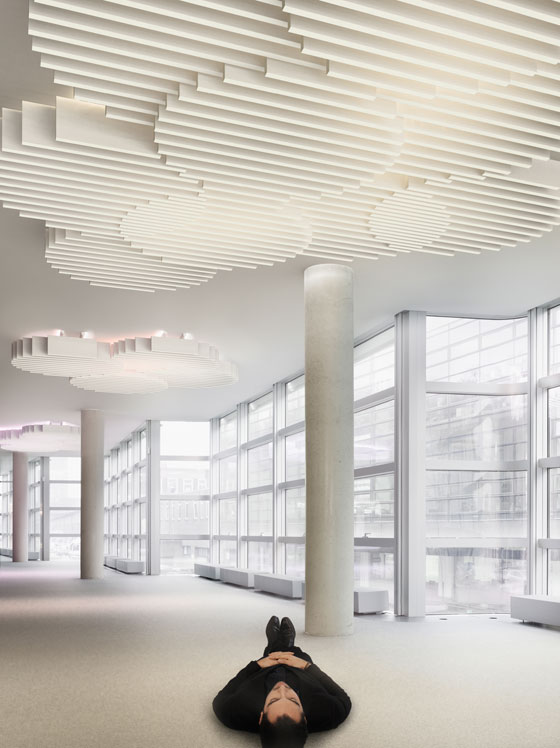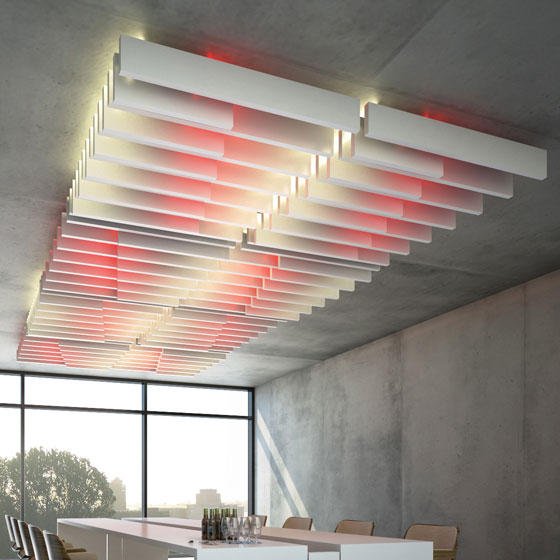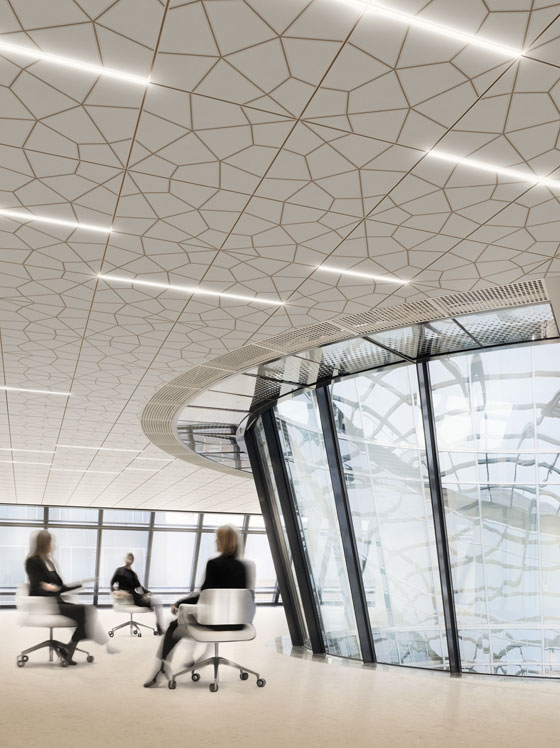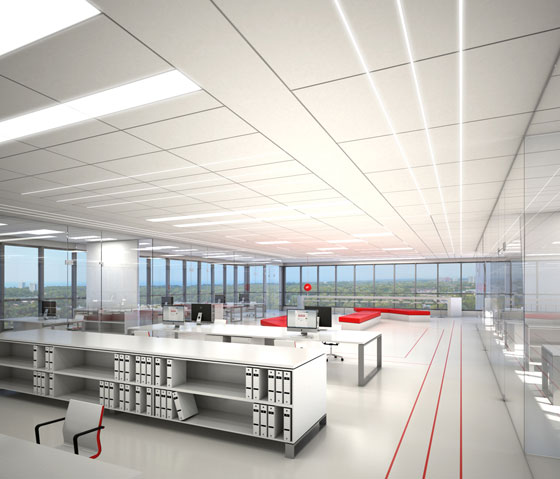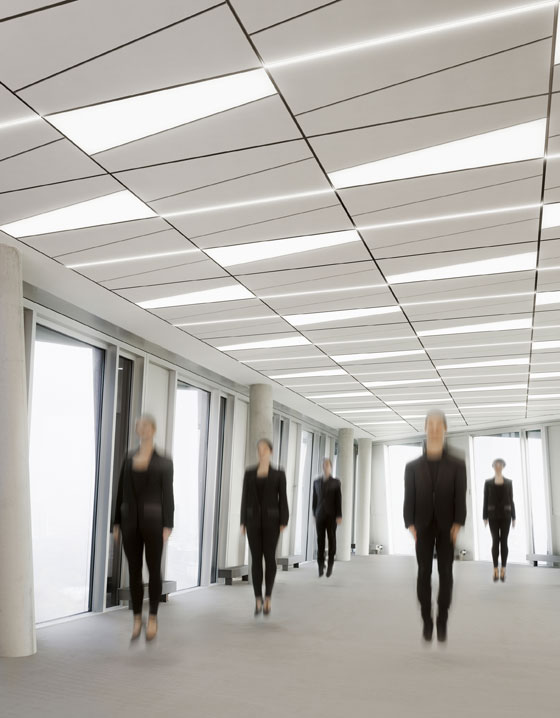The Only Way is Up: OWA's ceiling systems
Historia de la marca de Ulrich Büttner
Amorbach, Alemania
21.09.15
OWA, based in the Bavarian town of Amorbach, has been developing ceiling systems since 1948; first in woodfibre, then in mineral wool. Its latest offering, the 'OWAconsult collection', treats the ceiling as a three-dimensional object, imbuing it with optical interest as well as acoustic smarts.
Although seldom noticed by building users themselves, the requirements for suspended ceilings are highly complex and relate to such aspects as room acoustics, fire prevention, moisture resistance, lighting, clean-room standards, hygiene, cooling, printability and ball-impact resistance.
OWA is well acquainted with its markets and has succeeded through a sure-handed approach in opening all doors to the future over the course of the past several decades. While facing the realisation that his company needed to develop something truly new – that is, extraordinary products with unmistakable distinctive features – OWA Managing Director Mathias Schaper happened to meet the Hamburg architect and designer Hadi Teherani. A spontaneous brainstorming session paved the way for an efficient and productive collaboration from which the OWAconsult Collection emerged.
‘Hadi Teherani worked closely with the company’s development department from the outset and developed his designs on that basis. The objective was to produce a collection that would have a totally new impact, while relying on the existing equipment systems to the greatest extent possible. Economic feasibility is not an incidental aspect when it comes to product development,’ explains OWA Marketing Director Ben de Sain, adding that ‘our in-house evaluation ultimately led to the selection of six proposals, which were then designated for inclusion in the projected OWAconsult Collection.’
Short decision-making paths within the family enterprise and smooth cooperation between the designer and the OWA development department were the key contributing factors to a timely realisation of the original ideas. It was a work-intensive process requiring continual revision, optimisation and adjustment in order to achieve perfection in detail. Even such issues as the integration of LED lighting strips and light fields, and the question of suitability for use in suspended systems revealed the natural limitations of more than one idea for a ‘great ceiling’. After all, the world of suspended ceilings is focused primarily on systems and rarely on insular solutions. Thus the achievement of market-readiness after only six months is attributable not least of all to the considerable know-how contributed by the OWA team.
The six products in the collection are Flexo, Pix, Oriental, Trapeze, Square, and Cloud. They dispense entirely with the monotony of white squares and enhance the appeal of the suspended functional ceiling as a field of design for architects. Trapeze not only overcomes the limitations of the square and the rectangle, it also makes a convincing case with flush LED light fields. LED light strips are available for only five of the six systems.
Cloud, the round, lamellar ceiling sail measuring 130 cm in diameter with a height of 15 or 20 cm has attracted particular attention. Combinable with any solid or suspended ceiling, Cloud is ideally suited for acoustic room retrofitting. If the planner combines the two versions skilfully, the outcome is a lively yet functional ceiling relief. Square offers a square basic shape and can also be installed in an interlaced configuration.
New developments of this kind require suitably adapted substructures; one cannot simply use the standard systems in place in a house. ‘Substructures have changed considerably in recent years’, explains Ben de Sain. ‘We essentially have two different systems for the OWAconsult Collection, one of which offers the option of integrating an LED light strip.’
Practically nothing is done without LED lighting in the industry today. This modernising trend began more than five years ago. Square and Cloud represent a unique departure from flat ceiling systems. They extend as three-dimensional objects from the ceiling into the room and offer appealing visual qualities in addition to improved acoustics. The choice of Cloud or Square is always based on design considerations.
At the Audi Training Centre in Munich, for example, Cloud was installed in place of the existing solution, as the rooms were too reverberant beneath smooth, flat ceilings. ‘That is often the case,’ says Ben de Sain, who points out the advantages of the ceiling sail in terms of its practically universal suitability for installation. ‘While modern architecture consisting of lots of glass, concrete, metal, and ceramics, etc., brings forth exciting spaces, they often pose significant problems with respect to room acoustics: users are often disappointed and planners stressed out.’
Well aware of these challenges, OWA offers a consulting service. Architects, investors, building clients, and installers can consult with OWAconsult ceiling specialists even during the earliest planning phase. Aside from matters of acoustics, the members of the OWAconsult staff are well versed in aspects of statics, fire prevention and design, among other fields. The sooner such consultation begins, the more effective its impact on the project or object.
The unique status of Cloud mentioned above is also evident in the production process. The systems – or more precisely the objects – are custom-made for each individual order – with maximum care and cleanliness. That is reflected in the price, but as with all products in the OWAconsult Collection, the ultimate effect amounts to a veritable ceiling evolution.

